#Factorio modules
Explore tagged Tumblr posts
Text
Factorio’s Module Problem
I’ve been thinking about this for a while, and it’s been an issue that’s bugged me arguably from the day I started playing Factorio. It’s the Efficiency Module. Specifically Efficiency Modules 2 & 3.
I’ve been thinking about this in no small part due to the fact in my MP save, we decided that each planet should specialize in their respective modules, and as the Gleba player that means I’m in charge of 2 modules, Productivity on Nauvis & Efficiency on Gleba. I’ve got both set up churning out a decent number of them, and upcycling the lower quality ones, at least for Prod mods, I’m waiting on a shipment of quality modules to start it on Gleba.
Which brings me to my issue. I don’t really like efficiency modules, I never have, and as the player with the most experience, my group follows my lead in this kinda thing.
When I first started playing Factorio, I believe the modules had only just been added an update or two ago, and I didn’t frequently use them. I tried with all three, and ended up sticking to Prods & Efficiency modules at first. But then I realized I didn’t care about pollution, so efficiency modules were only good at saving power, and I could just scale that up and ignore the pollution still. This was before nuclear OR flamethrowers, so my defenses were entirely laser turrets and solar. I’d just expand my solar grid since I cleared a large space & scale up.
I took a much longer time to warm up to the speed module, having to do the math and learn that while it increases the power cost to run the machine, the time saved reduces the electricity cost per item… from that moment on I was a believer in the Prod/Speed combo, especially after I saw how compact a Prod 3/Speed 3 Furnace stack was.
This left me only ever making efficiency modules for power armor. I did recognize the pollution reducing benefits of the module, but once you unlock flamethrowers and set them up as defenses, I found pollution management to be irrelevant. Flamethrowers will take care of even behemoths decently enough without any space science research, and by the time they show up (I actually hadn’t seen a behemoth before playing Space Age, and I’ve beaten the game a few times) I’ve already established all the sciences available in the base game.
So ultimately I find their usage… lackluster. But it gets worse, because it’s not just their usage I have to consider that they’re competing for a module slot. And that’s against a Speed & a Prod mod and both are good. Let alone in the base game, I can make the competing modules for the same price, so I usually have to consider which to craft before I’m even at that point.
But I should amend that I think the Efficiency Module 1 is actually good. When it comes into the game it provides a decent power reduction, is fairly cheap, and most players don’t have bases ready to handle the downsides of the other 2 modules.
So now with that out of the way, I’ll mention how they fair in Space Age: Poorly. Ironically despite the fact that the T3 mods have different costs now and the T3 Efficiency mod is the cheapest now (taking 10 spoilage in addition to the standard 5 blue, 5 red, and 4 of the T2 module), it still doesn’t hold up well. Like the Speed/Prod combo is broken because now it’s more viable to look at either Quality only, Prod/Quality, or Speed/Quality, and I think this is awesome that it isn’t straightforward what modules to combine and how anymore, but… efficiency is rarely the answer now. It still shines in reducing pollution on Nauvis, has a new role in reducing nutrient consumption on Gleba, and the power reduction can still be useful in a few places, but… 4/5 planets have power production mostly unchained from their pollution mechanic (Gleba pollution comes from farming mostly, very little is needed to produce significant power) and the last place is Space, which is a great place for the t1 modules, but… T2 & T3 you’re likely to be looking at foundries if it’s going to Aquilo & you’ll need nuclear or better anyways at that point, so power is less an issue than making sure it’s fast enough for ammo production, which… puts another win to speed modules here, because they’re better for churning out more in a smaller area, which is what you want there. Yeah, you do want to reduce power usage, but if you’ve got a reactor you’ve got 5.8 MW of power per turbine to play with, and a minimum of 40MW of heat too. This gets worse if you use quality reactors OR Fusion reactors, as the power density increases a LOT. The smallest fusion reactor build puts out 50 MW of power.
So… the real reason for this post though, is this. I felt something was off in the scaling of the efficiency module, and I realized what it is. It scales differently from all the other modules, which (with one exception) scale all the same.
Prod mods go 4% to 6% to 10% (1, 1.5, 2.5)
Speed mods go 20% to 30% to 50% (1, 1.5, 2.5)
Quality mods go 1% to 2% to 2.5% (1, 2, 2.5)
So those three (with the exception of the Quality 2 mod) all scale the EXACT same for their upside.
Efficiency mods go 30% to 40% to 50% (1, 1.33, 1.66)
If they followed the same ratio, Efficiency mods would have either 30% -> 45% -> 75% or 30% -> 60% -> 75%. Which might be enough to justify making them. Even that though… I’m not sure if it’s enough, as they STILL have to compete against the other mods because there’s only so many slots, and power is one of the easier things to scale up, rather than mines or a build itself.
I just wish there was MORE of a reason to use the T2/T3 efficiency modules. They’re basically useless as far as I can tell since they’re weak and by the time you get them, they help with a downside that’s much easier to just deal with instead.
#factorio#factorio space age#Factorio modules#efficiency modules#kinda a rant#admittedly I like the balance the T1 modules have#and the balance between the other three T3 modules#it just feels like they really aren’t that good#even for niche things#the tier 2&3 modules#I may not use the efficiency 1 modules often but I understand their use cases#I just don’t often use them to reduce enemy difficulty because I like the challenge biters provide#even on death worlds I was able to avoid using them
7 notes
·
View notes
Text
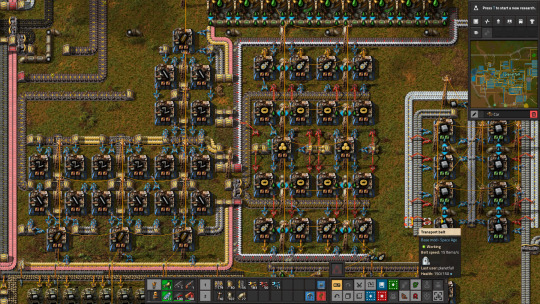
complex joints my beloved <3
#factorio#nothing like prod modules to ruin a perfect ratio. i shall shove them everywhere as always.
2 notes
·
View notes
Text
Ahem, I totally got these 1500 yellow science bottles to unlock Cerys Cargo Drops completely legitimately and I absolutely totally waited for literal hours to get the right amount of quality ingredients and deep enough into the mod to get this legitimately.
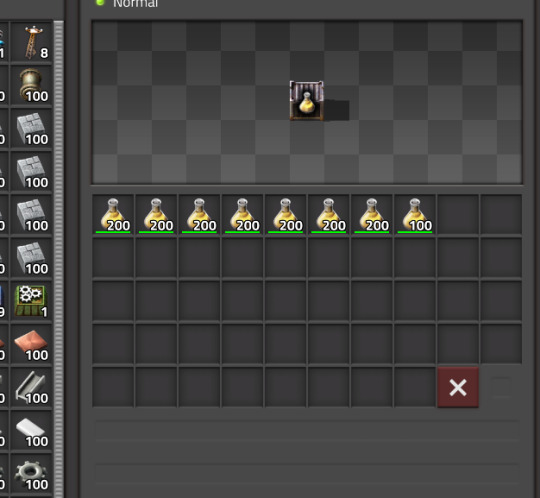
#factorio#factorio space age#if i have one complaint about the cerys mod its the mandatory quality#and the fact that you cant drop things onto cerys#i like the idea. but not with mandatory quality because quality without top tier modules is a pain
3 notes
·
View notes
Text
You could add efficiency modules. Spend half a megawatt to reduce the electric consumption of other machines by up to 80%! If you put them in the right place, you might save more energy than you lose!
they should make a different module to put in beacons besides speed
#unfortunately there just aren't that many variables you could build a module around#power consumption speed and input/output ratio are the big ones and they each get a module in the base game#what else is there? boosting buffer stack sizes? that makes efficiency modules look as good as productivity modules#factorio
14 notes
·
View notes
Text
Factorio: Space Age introduces the "quality" system, which you can technically play without, though I'm not sure it's balanced around that. I've now played with it enough that I have some thoughts on it.
First, I think it's kind of stupid that machines cannot naively use mixed-quality materials. It means that if you put a quality module in a single furnace, the lines will get "polluted" by the plates that are produced, and the whole factory will eventually gum up. Ask me how I know. I would vastly have preferred that it not matter: use a rare gear in a belt, and either it has no special benefit, or gives a chance to grant quality or something. But if it did that, I suppose it wouldn't be much of a gameplay challenge.
There are a few other pain points. One of them is that bots and the interface in general do not handle quality very well. Quality is almost always a strict upgrade, so it would be nice if there was a setting I could tick that said "hey, go upgrade things if possible". But instead, the UI and mechanics are such that you need to specify it, and this is super annoying, because it means that I have to manually go do the replacement myself, or have an upgrade planner to upgrade quality, then cancel the job once everything that can be replaced is so that the game will stop giving me an alert. I have accumulators and solar panels set up for quality right now, and I can't immediately think of a way to automate the process of upgrading the solar fields. I'm guessing that mods will help with that eventually. I also definitely want a keybind for "increase quality" and "decrease quality" on a machine, though I guess I never went looking to see whether that was a thing, so maybe it exists and I'm ignorant.
So as I see it, there are three main ways to engage with the mechanics:
Put quality modules in a machine that you're going to craft once and hope to roll high. The advantage is that hey, maybe you'll get lucky, and for stuff that goes in the equipment grid, I think this is sensible to do. Probably also wise for infrastructure, so long as you're fine doing some manual finagling that really should be done with bots.
Put quality modules in (some) machines that make intermediates, then use whatever you skim off the top there to make quality things. This does work, but you have to skim off essentially every single production line, and I think over time you end up with too much of certain things, which kind of sucks. It's one of the things that I've been doing, since it can guarantee the higher quality stuff, and ideally all the stuff in a spaceship and your equipment grid is at highest quality available. (You can also "skim" off anything you're making a shit-ton of for science: electric furnaces and yellow inserters are the two most obvious ones. I do wish this were easier to automate so that at some point you could say "actually, don't do the quality thing anymore". Probably some circuit logic could get you there, but you can't replace modules automatically that I know of.)
Use the recycler to "reroll" quality, making a gear over and over and over until it rolls high and can be separated out. The only issue with this is that it requires the recycler, and also is very expensive, but it does mitigate the randomness in its own way.
There's a secret fourth way that I've been noodling, which is that you could essentially build five separate copies of your base, put quality modules in everything, then if you roll high, send the better materials to the other base. This is insane, which is why I like it. So you would have miners mining with quality, which then gets separated onto five different trains and brought to the smelters, which then turn some fraction into higher quality plates that get sent to the "higher" factories. Those plates go into assemblers, which have a chance of upgrade, and so on, until there are five sets of labs, each of which is working with a different set of quality flasks. But I'm pretty sure that this would have a lot of technical problems, and really risk gumming up, as well as being very space inefficient and resource intensive. Still, might be workable end game, if you could deal with the inevitable overflows and imbalances.
Overall, I like it as a problem to chew on, but I think in practice they made a few decisions that I find annoying. Mods seem like they're fix some of it, like having to manually select upgrades, but the "clogging up the inventory" issue isn't going to go away, and in fact seems like one of the basic things that the mechanic is balanced around. I really appreciate that there are many ways to approach it, and that it creates this tradeoff of "go tall" or "go wide".
I'm very curious to see what people do with it, though I think the "throw vast resources into recycling" approach is probably going to be the dominant one unless there's a great blueprint for handling the overhead. And I'm also curious where public opinion is going to land on it, since it seems like the kind of thing that might end up divisive.
17 notes
·
View notes
Text
Something that mod packs like better than wolves or games like vintage story don't seem to understand is that suffering in video games is fine, but there needs to be SOME kind of pay off to getting through the suffering.
Progression is an important part of survival/open world games, there needs to be some level of "you've passed B milestone so now the A tasks are considerably easier but you've also unlocked C tasks which match A tasks original difficulty but allow you to work towards D milestone which unlocks E tasks etc etc etc"
Minecraft does an ok enough job of this even though BTWtards will pretend otherwise for reddit updoots. But, as can be said about any topic around video games, factorio does it best. Start off hand crafting, move to hand feeding, then basic automation, oil processing, alternative power sources, logic circuits, trains, scaling up, beacons and modules, robots, artillery, spidertrons.
Each of these paths are not only unlocked through the overall progression but are made easier by embracing the other paths. Scaling up is easier once you start using bots, trains or move to nuclear power. Which are all easier once you embrace advanced oil processing. Beacons and modules can make pretty much anything easier but require sizable automation to use at bigger scales. Robots are such a huge milestone they essentially divide the game into pre and post bot but you can also go the entire game without crafting a single one.
At the start of the game realizing you need another belt of iron plates when your current iron latch can't support another belt is a big task. You need to locate a new patch, manually take out the biters with a tank or turrent creep. Manually build a new mining post on the ore patch, bring all the ore back somehow (trains or belts, which both bring their own time to build). And then you need to actually smelt the iron which means a building a new furnace stack by hand which means either more power drain or more load on your coal patch which it might not be able to support which starts this whole process over again.
By the end or even late game it's a whole new scenario, noticing you need a new belt of iron is never more than three blueprints and a spidertron away from a solution. You can have everything building and running in the background while you work on more stuff that takes more thought than basic copy and pasting. By the end game you spend more time designing than actively building.
Minecraft does ok at this even though some milestones are laughibly easy. Making a mob farm makes collecting stuff like gunpowder easy. Making an iron farm makes building anything big that uses hoppers actually viable. Villager trading halls turn good enchantments into something you can work toward rather than rolling the dice at the enchantment table 400 times.
Trash like better than wolves fails at this. You will be scrounging and toiling away for food every single in game day until you beat it, there's never a point in progression where some core part of the game becomes a non-issue, if you're lucky it just gets 0.5% easier. What once was a task you had to sit and hold right click for five minutes while holding an item can now be accomplished by right clicking a block once and waiting four minutes. Whoop dee fucking doo.
7 notes
·
View notes
Text
More Factorio speculation!
Vulcanus's metallurgic science introduces the Foundry, a sort of super-smelter that can make metal plates, gears, wire, etc with an inherent +50% production bonus and five module slots.
Fulgora's electromagnetic science introduces the Electromagnetic Plant, a sort of specialized assembler that can make circuits, electrical equipment, modules, etc with an inherent +50% production bonus and five module slots.
I expect that a building like that will be present on every planet in the Space Age expansion. So what's left?
The only big category of resources that isn't touched by either the electromagnetic plant or foundry is oil/chemical stuff; plastic, sulfur, lubricant, fuel, etc. So I feel confident that the third planet's special building will be some kind of enhanced chemical plant.
Which probably means we'll be getting a novel oil processing process on planet #3. Maybe the reverse of what Fulgora's oil sands have? Something that makes heavy oil important for more things than lubricant, some resource type that gives lots of petroleum gas, and a reverse cracking recipe?
If that's true, maybe planet #3 will be something like Titan, or like Titan crossed with Europa. A barren world, cold enough that ethylene condenses into pools on the surface.
But that's just a guess built on a foundation of more guesses. It could be something completely different, like a planet whose industry focuses on weapon stuff or uranium processing or something.
We'll find out eventually. We found out about Vulcanus three months ago, and Wube estimated a release date "about a year" after almost exactly six months from now. So I'm guessing we'll see a FFF about planet #3 some time around late May, and the final frontier either right before or right after the August release. Or at least, that's what I'm guessing Wube has scheduled; time will tell whether that works out!
While I'm here I'm guessing the final planet's Special Building is either some kind of super-rocket-silo, or a way to use science packs for purposes other than science. I think it would make sense for some of the last (non-infinite) technologies unlocked to be things that make linking planets together easier—a way to get resources from planetside to space platforms more easily, or upgrades for space platforms, or maybe something wild like interplanetary teleportation.
18 notes
·
View notes
Text
Factorio posting is easy. It may or may not make my top tier list for games, but it's easily one of my top five favorite drugs.
First time playing, I did the tutorial and have started the main game, somehow I'm already 100 hours in. That doesn't include the hours I've spent doodling plans but it does include the hours I've spent with it paused pacing back and forth.
Still gotta laugh when I open the map, since I remember starting out, just getting up to military science, I never imagined I'd run my main assembly lines into my power plants, up by the lake. (I now know, of course, that my power plants should've been near the coal, it's way easier to move water). I thought it was silly how far I could zoom out. When my iron started petering out, the rail run to another iron mine felt massive. Now...

Excellent design in this game, they gave me construction robots right when I started to feel the strain of manually deconstructing and rebuilding. You can probably tell I wanted even logistic coverage. When I first started rebuilding, the base was almost square, but then I've had to expand a couple times.

It's hilarious how quickly that lake turned that lovely putrid green as soon as production started ramping up.
I wanted to keep the crashed ship 'cause it amused me. I was gonna build the silo right in front of it: "Space ships go up, not into the ground, see?" But LDS production really needed too much space.
I just got artillery and started a machine on producing shells:

And realized my science was drying up. Apparently my first oil field is tapped out, so plastic stopped (so advanced circuits stopped so processing units stopped so utility science, you know). Was just thinking about expanding my outlying mines and experimenting with a rail circuit between them all, so I guess I'm also going to be adding a new refinery.
Also thinking about an outer circle of rail with artillery wagons, keep the biters pushed back.
Still not satisfied with well, almost anything. I'm sure there are better ways to do it; completely separate from having an intuition of how much space a given production line needs.
Maybe once I've sent that first rocket up, I'll go look up what the "meta" is.
I feel like it fits the spirit of the game to set up for mass production of rockets though, produce space science at the same rate I'm making the rest of it. For that I'll really need those extra mines, since that's like 22 LDS and 11 processing units being assembled at any given time.
I also need nuclear power going before that, I'm already throttling on watts sometimes. I should've a while ago but other redesigns kept getting in the way. Hopefully the next time I start a new game (probably when the Space Age expansion comes out) I'll be ready to get it online on time.
I'd kind of hoped to do all the rail and mine expansion while cruising around in a giant spider, but I need that plastic to do that.
Once I'm reliably getting more material and power, I'll build out the rocket part stuff to the west and north-west, win the game, then expand my factory to cover the globe.
... I have been playing so much Factorio that my queue is now empty.
#factorio#original#also starting to drop some more modules in more devices#like production in the utility science and express transport assemblers maybe speed in the drills and pumps#might figure out how to use the circuit network to regulate supplying repair kits and ammo to the satellite bases#ugh seriously? biters camped out on that uranium patch to the south? gonna have to deal with that too#thankfully I can tell that once I've gotten a few of those heavy production chevos I'll be ready to put this on the shelf for a year or so#wait a sec production modules only work on intermediate items so they wouldn't help with the express belts#this post came late because I'd fire up the game to take screenshots and then start playing for a few hours instead
48 notes
·
View notes
Text
Factorio Space Exploration: Arcosphere Cookbook with explanations

I found the arcosphere puzzle intriguing but poorly explained and clunky, and when looking for advice I found a lot of other frustrated people who were brute-forcing the puzzle, using giant combinator fields, and/or copying entire solution blocks from other people's blueprints. I have further complaints, like the strict spoiler policy and the F:SE wiki deliberately avoiding this info, so I'm going to talk about arcospheres and try to make this be something like the reference I wanted. I will try to explain principles, not just solve, to help people understand. This will be long, and have colored diagrams.
Contributing to my frustration is that Arcospheres are a finite*, accidentally losable resource that are required for victory. On the Cruelty Scale from interactive fiction, Arcospheres put Space Exploration somewhere around Nasty. Having a spoiler policy on top of this is rude!
So. When you first get spaceballs, they are bland grey. You can get some from looting ancient ruins and the Interburbul game on other planets, but the main source is from the deep void, by launching arcosphere collectors from deep space asteroid fields. These have diminishing returns, so start with about 5 from each field. Make sure to launch the collector, not the arcosphere, I've seen one guy lose his spheres that way because he was outputting silo spheres into the same container that collectors were loading from, and the loader loaded arcospheres instead.
Then you put them through Arcosphere Polarization. This takes in 4 grey balls and puts out a set of 4 colored arcospheres: either [Lambda, Zeta, Epsilon, Gamma] or [Xi, Theta, Phi, Omega]. Do some of both recipes to get all 8 types. A machine set to run continuously will randomly flip between them - this comes up later - but you can manually set it for your first few spaceballs.
Arcospheres are unusual in that they're not consumed like most ingredients in Factorio, instead they are merely transformed between the different polarities. The recipe for a Naquium Tesseract takes in 3 arcospheres [Lambda, Xi, Zeta] and outputs 3 arcospheres [Theta, Epsilon, Phi].
Productivity modules are banned here, naturally.
*Finite: Arcospheres are hard to produce, with arcosphere collection from space having logarithmically diminishing returns, which means at some point it would take a lifetime of play to get another set. Make sure to keep them well protected from biters, meteor strikes, spaceship landings, and so on.
Since the full names are heck to diagram and the greek letters are heck to type, I'm going to refer to the 8 polarizations by their English-language initials: L, X, Z, T, E, P, G, O. That's the order the items are sorted ingame, don't blame me.

Next it's useful to visualize the various arcosphere folds and transforms. Since there's 8 of them, we can map them to the corners of a cube, and a cube is relatively simple to diagram as two squares. I will label the corners in semi-clockwise order, which makes several of the folds easier to visualize the patterns for, and color them correspondingly. Starting with the Arcosphere Polarization, you can see it produces either inner (LZEG) or outer (XTPO) spheres.
Next is the Arcosphere Inversion basic recipes, it would be a nuisance to memorize exactly which four invert, but with the diagram...

...it's swapping the diagonals. Inversion is invertible.
Then there's 8 kinds of basic Arcosphere Folding. The first one is [LO] -> [XT] and we can think of this as X-centric. Each fold is centered on a corner: it takes in the "previous" (counterclockwise) and the parallell sphere, outputs the chosen corner and the "next" (clockwise) sphere. Each fold takes one inner and one outer sphere, outputs either two inner or two outer. Here's the X-centered and the L-centered fold.

Here's all eight of them in a block. Stare at it, feel the patterns.

With this, I find it much easier to think about recipes in terms of "I have..." and "I need..." when I know they move sorta-clockwise, and are output in adjacent pairs.
Also, each column as presented forms a combination to build from. If you have [OL,XG] you can run the two leftmost recipes and output [XT,LZ]. Reorder these and it's [LXGO] -> [LXZT]. We have used LX as a catalyst to turn GO into ZT.
This generalizes by rotation. If you have one of the half-diagonals such as [LX], [ZT], [EP] or [GO], you can convert it into the opposite half-diagonal this way. This is the 1st combination recipe.
Here's what this looks like in practice in Factorio, with the pair from the fourth column that combines [GP]->[OX] and [EO]->[GL], with a net result of [EP] -> [LX].

[EP] comes in at left, is taken up by the first set of filter inserters. [GO] is a catalyst, passed between the two gravimetrics machines indefinitely. [LX] is output to the right.
In addition to turning a half-diagonal-pair into its opposite with 2 catalyst spheres, any two of a single polarity can be turned into their opposite with 1 catalyst. (Opposite corner cubewise, so L becomes P, not E.) This is the 2nd combination recipe.
You may want to copy the Eight Folds diagram to use as a reference for the individual steps here. Starting with for example two Lambda, we use an Omega as a catalyst, and perform the following folds, converting the pair marked in brackets at each step.
L [L O] [L T] X E [Z X] [E T] P O P P
And here's that built in Factorio:

Place an [O]mega catalyst in the upper left machine once the very first time, then insert many L in top chest. They will be converted to P, and the O catalyst returned to upper left after each pass.
The topmost filter inserters from the L chest are wired to take only when (Lambda > 1) to ensure even splits in my demo, you could use a splitter belt or something else for the same effect. The middle red long inserter uses a nonobvious Factorio feature: when pointing into a machine, inserters will only take ingredients needed in that machine's recipe, so it will only take the E and not the Z from the top-right machine to the lower-left machine.
The full set of 8 opposite-corner chains:

Now we've got the Inversion recipe that switches full diagonals of 4, turning a diagonally adjacent pair into the other half of the diagonal, and turning a single ball into its opposite corner, and. That leaves one more building block of useful folding combinations:
Turning an opposite-corner pair into the other two on its long diagonal. This phrase sounds clunky even to me, so here's the visual: starting with a bunch of L, generate LP, and from there XLEP.

The [LP] -> [XE] transform is accomplished with only one catalyst ball, but needs more balls to be converted. You need to start with LLPP, and use T as catalyst into XXEE, with subelements of [LP]->EE and [LP]->[XX]. This is the 3rd combination recipe.
The specific steps: [TL] P E [ZP] EE G and then use that G as intermediate catalyst for [GP] L X [OL] XX T giving you the T back.
This takes a little bit of sorting input to build the machines. Factorio build with similar 4-machine shape to the above, note again the wired inserters set to (L>1) and (P>1), can be replaced with belt splitters or other method of even distribution. The whole system can be rotated and rearranged. Think of this as a Lego-like toolkit, not a definitive solution. (That's why I'm posting diagrams, not blueprints.)

Place a single catalyst T in the top-left [LT] machine to start, and the system will turn sets of [LLPP] into [XXEE], returning the T.
The four sets of this are: T as catalyst to turn [LLPP] into [XXEE] O as catalyst to turn [XXEE] into [LLPP] P as catalyst to turn [ZZOO] into [GGTT] X as catalyst to turn [GGTT] into [ZZOO].
Let's revisit the diagram.
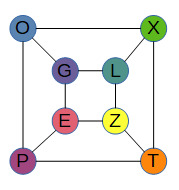
Starting from a bucket of one single arcosphere such as L, you now have the steps and components to:
Turn it into the opposite corner. (-> LP)
Turn those opposites into the rest of the diagonal. (-> XLEP)
Invert the diagonal. (-> OGZT)
Turn two diagonally adjacent balls into the opposite diagonal. (OG < - > ZT.)
and the rotations of these.
Combining these steps now gets you from any ball to any other ball, in sufficient quantities. For example, if you're running the Naquium Processor recipe that outputs five Lambdas, and you want to turn your stack of L into E:
L -> LP with opposite-corner LP -> XE with on-diagonal X -> E with opposite-corner.
With the building-block theory done for converting arcospheres, let's look at productive recipes featuring spaceballs. I'll start with the first data card from Deep Space Science 3: Space Folding Data.
The recipe for this card comes in two flavors: each takes Naquium Plate, Significant Data, -273C Thermofluid, and arcospheres [LX]. One flavor outputs ZT, and the other flavor outputs EP as our arcospheres. You can manually choose which the first time, but Factorio is all about the automation, and a machine set to automake Space Folding data may randomly swap between recipes each time a crafting has completed! So you need to plan for getting a mix of ZTEP out, unpredictably. Let's consult the diagram again. White for input, but grey and black for the two sets of output.

Well the EP is easy: just convert it back to LX, using a set of OG as catalysts.
The ZT output is a little harder. Convert half of it to OG (using a set of EP as catalysts) giving you the OGZT diagonal, then invert that into XLEP. Then filter the XL back into the data card maker, and and the EP can convert to XL.
How this might look in practice, zoomed out and labeled:

Zoomed in and cropped so it's easier to see filter settings:

Tracing the path through this system, start with the machine on the right. Insert some LX. If it comes out as EP, it takes the upper belt leftwards, and gets converted back into LX, easy peasy.
If it comes out as ZT, the two lower filters put that onto belts, and split them so that some ZT goes to become OG at the bottom, while the other ZT goes to join the fresh OG in the OGZT inversion machine on the left.
Space Warping Data is very similar and straightforward. You input [EP], get out OG and/or ZT, you convert as necessary until you have an OGZT set to turn into XLEP, and turn the extra XL into EP.
Space Dilation Data is a little harder. You input [ZO], and get out either LL or PP. Conditional wires on your inserters start to be useful here, as does having more arcospheres for a buffer when the random number generator is streaky. Hope for LLPP; but plan to convert LLLL or PPPP into LLPP. Turn some of the LP into XE, then a whole XLEP diagonal inverts to OGZT, and GT can be converted into OZ.
Space Injection Data gets tricky. You input [GT] and get out either ZZ or EE. For the first time, these aren't on the same diagonal. Oh well.
When you get Z, convert half of it to O with opposite-corner, then ZO to GT.
When you get E, convert half of it to X with opposite-corner, then convert half of the resulting EX mix to LP, giving you a full diagonal. Invert the XLEP diagonal to OGZT, and then convert OZ to GT. This requires five sets of folding combination machines, and it sprawls quite a bit and wants a large buffer of extra spheres.
I will note one more data card later in tech tree: Wormhole Data, [LZEG] -> [XTPO]. No randomization here.
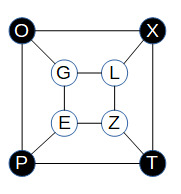
This is a sneaky recipe, because the diagonal steps described above can be used but it gets much larger than necessary because they're a poor fit.
Notice instead how this takes inners and produces outers. What turns outers back into inners? The basic Arcosphere Foldings.
Produce a set of XTPO, and keep a spare set of LZEG as a catalyst. Run the lower four basic foldings from the Arcosphere Folding block once each, like [XG]->[LZ], producing [LZ]+[ZE]+[EG]+[GL], or two sets of LZEG.
For the other recipes, like Naquium Tesseract, hopefully these visualizations and combinations have helped you understand what's going on and how to build your own design from parts. Or you can download someone else's solved blueprint. You don't need to bash your head against a wall of obfuscated math to play with spaceships.
You are welcome to copy, annotate, share and edit this guide as you like.
9 notes
·
View notes
Text
Say hello to my longest most time consuming Factorio build! Its got everything!
Filtration to purify thermal water into mineral sludge
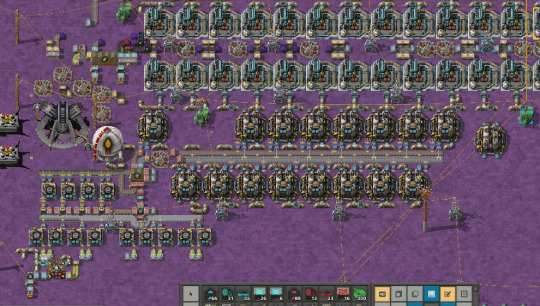
Crystallizer to turn mineral sludge into radioactive material, sorting facility to seperate uranium and thorium, and fluorite to send to further processing
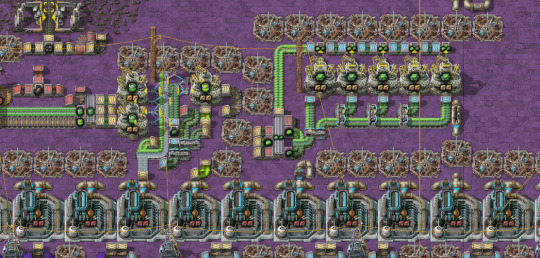
Full assortment of centerfuges for both fuel cells and material reclamation

Tertiary Uranium 235 generator array surrounded by EEB Turrets and laser turrets
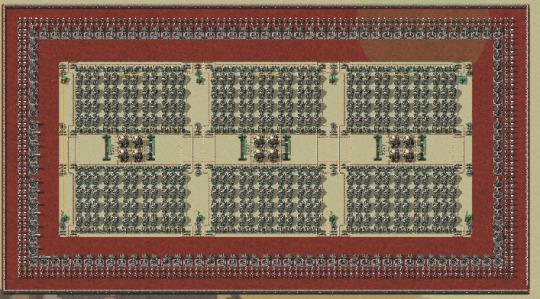
5 car train transporting important goods between all 3 mega bases with plans to expand another 2 rail systems for more bases
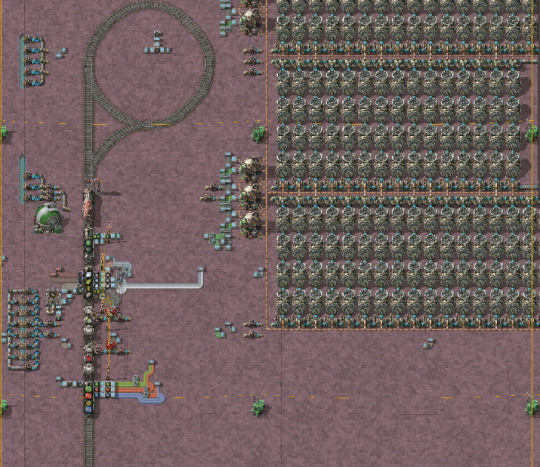

Air filtration system surrounding most mega bases to prevent the spread of pollution
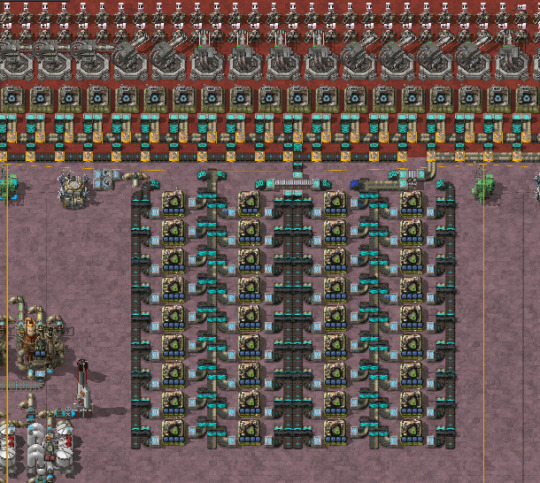
Fish and puffer breeding alongside crops

Tier 3 module production
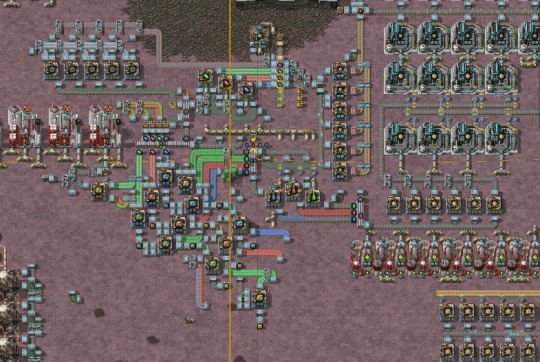
Backup solar power on SR latch (to keep nuclear reprocessing moving) in-case all 6 nuclear arrays fail (Uranium 235, MOX, Thorium, and Deuterium)
Saphirite processing including hydro cells

blast furnace, induction, and casting machines

And so much more! ^.^
#Yes I did use the map editor for most of this#but its my biggest build#Probably a thousand hours in this save alone between design execution and redesign#started as a testing save for my survival save but I just kept expanding it when i'd forget which I was on#factorio#clover writes#people have diagnosed me with autism over this save
4 notes
·
View notes
Text
Factorio is a fun game because my buddy can invite me to see his megabase and I can help him work through how to get 3x more energy out of his nuclear reactors by accounting for neighbor bonuses and precise ratios between heat exchangers and turbines.
And then he can come and see my base and say "damn, you live like this?" as I'm immediately swarmed by no fewer than 10,000 spitters because I'm still running everything off of 200 steam engines and I have zero efficiency modules on any of my drills or assemblers and nothing but desert for my coal baron smog cloud to dissipate over.
5 notes
·
View notes
Text
Factorio Space Age: Gleba
Since I recently reblogged a post about Gleba, I figured I should go into more depth about it. In a week or two when I graduate I’ll go into more detail about it, but I’ve probably spent the most time of the expansion on Gleba, exploring things like Quality, the circuit network changes, and sushi belts. I admit some of the tech I learned on Gleba ended up being essential for a later rebuild of Fulgora & stuff I learned on space platforms went to Aquilo, and then what I learned there got brought back to space.
Regardless I figured I could share some of the overall lessons I learned on Gleba & beyond during the DLC that helped me “master” Gleba.
-Identifying where spoilage & freshness matters
There’s a total of about 13 items that can spoil, and they spoil into one of six things: iron and copper ores, spoilage, and enemies. As you want iron/copper ores, we can ignore spoilage here, they become the thing you want typically so except in the production loop, this is a good thing. For spoilage, it’s an item, and you should generally assume anything that stores a spoilable item in it, is going to at some point have spoilage in it, and it will need to be removed. EVERYTHING, including things like biolabs. Lastly enemies, they don’t leave behind items so you don’t need to clean out the machines, but you probably don’t want them wandering around, so you likely want some defense to kill them if they show up. They can wreck havoc on things like space platforms or power plants if they get there, but generally they’re more a nuisance than a threat, so long as you don’t let a massive amount spoil at once… (Most I did was let 100 biter eggs spoil in a chest surrounded by lasers. Didn’t even notice it happened).
So clean up spoilage, and handle “Hazmats” (eggs & spawners) with military or disposal methods (pentapod eggs can be burned & biter eggs mulched into nutrients). Another tip for the Hazmats is to not store them in chests unless necessary (rocket silo loading), and to not put them in assemblers/biochambers unless they are the only missing item. I seriously recommend setting agricultural egg inserters to hand size 1 & to only insert if they have bioflux. (Wire the biochamber to the inserter, use read contents & enable/disable). It might slow down your science slightly but it does make it so you don’t need turrets by the science area.
Spoilage itself can be easily disposed of by either converting it inefficiently into nutrients, or burning it in a heating tower. Personally I use nutrient crafting as a spoilage upcycling system to produce high quality spoilage for efficiency modules, or high quality carbon for coal synthesis w/ asteroid mining for the matching sulfur. (I.e it’s a supplement for Legendary plastic for red circuits and LDS shuffling…)
As for where freshness matters, it actually only matters in a few places. Not all recipes do actually inherit their freshness from their parents (bacteria & pentapod eggs are top of my mind, but I think Fish also don’t), nor does freshness matter if the finished product isn’t spoilable. Ultimately freshness only really matters in the items directly connected to lime (agricultural) science as it’s the ONLY item in game that freshness impacts how useful it is. 5% fresh bioflux will feed a biter nest, as will 5% nutrients a biochamber & so on. Freshness only really matters if you need to move something or if it’s for lime science. So generally with that in mind you can send all your near rotten fruit and other spoilables for producing things like ore, rocket fuel, plastic, lubricant, sulfur or carbon fiber.
Another key idea is “shelf-stability”. You generally want to move raw fruit, bioflux & lime science around because they have long shelf lives. You don’t want to move jelly, mash, or nutrients around because of their short shelf life. It’s much easier to move jellynut, yumako, or bioflux instead and all of them are more space efficient to move as well.
-The Spores, Simplicity, & Quality triad
From what I found it is impossible to create a base that is simple, spore-efficient, & produces quality. At best you can do two, and I suspect it is genuinely impossible to do all three because of how they interact.
So I suppose I should define what I mean by these things. Spore efficiency is basically a measure of how much of the fruit products you make turn into spoilage. A more spore efficient base has less products rot. Why? Because the less products that rot, by definition, the more of your harvest WAS used for production rather than was wasted. While spoilage has its own uses, it isn’t ideal for most production in your base, unless you plan on mass producing only coal. Simplicity is how much of a headache setting everything up is. The more circuit conditions, belt priority shenanigans, and other complexities in the build, the less simple it is. And quality production, I mean large scale quality production, which usually relies on inter-step processing to roll up the products.
But wait you might be asking yourself, this implies it’s possible to build a quality base that’s easy without it being a major headache? Yes! Quality lime science is arguably one of the easiest sciences to produce in quality, only truly rivaled by the easy of quality space science in the late game! My first rocket silo of lime science was 1k rare science. This is because pentapod eggs are a catalytic recipe that can take quality modules, and so rolling up a high quality egg once is super easy, and then you just need to keep feeding it with high quality nutrients… which comes from bioflux, the other item you want to raise in quality! And you can even use a spoilage upcycler to supplement this to prevent the eggs from going off. I’ll show off a surprisingly easy to design base for producing rare quality science in the early Gleba game sometime later when I show off some Gleba designs.
However I do need to point out that the triad does inherently conflict. Trying to reduce spoilage amounts by simply reducing fruit in caused quality to stall. Trying to get quality up again caused it to become more complex, making a newer less-complex design required me to gut quality… you have to decide WHAT you value going in.
So for my MP base I decided I would cut quality, and focus on spore efficiency, as I wanted to produce the most science with the least spores, as I couldn’t rely on Tesla Turrets from Fulgora to protect me.
-Spore efficiency maximization
One of the best ways to actually improve spore efficiency is to start at the fruit production itself. Every second a raw fruit is waiting around, it is getting one step closer to rotting. Why harvest if you don’t need to? Keeping planting going without harvesting is simple if you keep in mind that agricultural towers prefer to plant first, then harvest. So if you wire the tower to anything, and set it to output inventory & only work when seeds > 0, it will only work when it has seeds in it, and will prefer planting first. Which means it will only harvest if there are no plantable spots and you put seeds in. Which means you can control harvesting by controlling when an inserter loads seeds in. So have the inserter only put seeds in when you need more fruit (you can use a circuit condition, like fruit less than 50 (one harvest) to determine when to start a harvest and load seeds in one at a time, if this is your only condition, you’ll probably produce 2-4 stacks at a time depending on your inserters).
Likewise… if you control when you process the raw fruit into jelly/mash then you can again further reduce spoilage. You can use a similar method to the harvest, but by turning off the biochambers for those lines. This reduces fruit usage, which will decrease tower usage & spore output… yet since you only produce the jelly/mash when needed, the assembly line shouldn’t actually slow down. What might happen though is that your power production dips because you’re not burning as much spoilage.
Well that’s a very easy fix. Gleba has the CHEAPEST rocket fuel recipe in the game, especially if you look at the fuel values of its ingredients. It is the ONLY power positive rocket fuel recipe in the game without productivity, and it has a default 50% bonus to it too! Literally no other rocket fuel recipe can get that bonus except the base recipe which requires exported biochambers to Nauvis! (Or Fulgora technically, but why would you do that? Oil is free there) Which is its own nightmare. So you can actually just burn rocket fuel for power in a heating tower! Which has a 250% fuel efficiency, meaning 100 Mj of chemical energy (one rocket fuel) becomes 250 MJ of electrical power! Excluding startup costs for the heating towers.
Well I’d recommend against burning all your rocket fuel because that’d just gobble it all up, but what you can do is measure the temperatures of your heating towers, and if they drop below a certain threshold (I recommend at least 600 degrees) to feed in rocket fuel.
Since I hooked up this failsafe to my power plant the only blackout I had was when I accidentally burned all my yumako seeds and stalled the entire factory, and it took almost an hour for it to begin to get close to a brownout, and it hadn’t when I found out the problem (I had an alarm if the power plant went critically cold (all towers below 600 degrees), so I could intervene before power goes out)
How you decide to reduce spoilage from here is up to you. I decided on my second run to just dead end belts and extract spoilage rather than run them all to the incinerator, so that lines could just pull half rotted mash/jelly for things like lube and ore. Only bioflux has a flowthrough section, and I overbuilt lime science & eggs so it never backs up there either (I’d much rather have rotting lime science than make half rotten lime science)
-Finally… solving the “How do I load my freshest items into a rocket?”
This is much easier than people think. It takes 2 chests, a logistics provider of some flavor (I use red) & a steel chest (wood/iron would work too). I then place the chests a tile apart, and have the inserter wired to the logistics chest. It’s set that if I have more than my desired storage amount (usually one rocket’s worth, sometimes two rockets) it grabs the MOST SPOILED item from the provider and puts it into the steel chest. This removes the item from the logistics network (and the rocket silo therefore) which will turn the inserter back off if the chest no longer has more than enough for the rocket launches requested & reduces the average spoil time of the chest. This is key. The individual items are still spoiling, I’m not managing to magically remove spoilage, but I am reducing the average spoil amount. When a rocket comes, it takes the items from the provider chest and it will gradually fill up again. Since only the freshest 1k items are typically available, this means I always load the freshest items I have. I could then feed in some items back from that “rotting chest” if I wanted to, but I find it’s more trouble than it’s worth, and I’d rather just produce a fresh 1k usually… I might play around with feeding it back in, but I only do this with science… extracted bioflux in this system gets fed into production elsewhere, instead of into a secondary chest. The whole point of the chest was just to act as a large storage vessel for composing science to spoilage.
Anyways, as someone who actually liked Gleba I talked about everything I can without getting into the specifics of like… how to build Gleba with bots, belts or trains… which I would love to cover at some point, because I do think there are too many content creators out there that don’t do Gleba justice… (Looking at Nilaus… I died inside when I saw he just plopped down a bot-base and a parameterized biochamber mall essentially. Dosh likewise also disappointed me on his OG Space Age run with his Gleba (import based) and Fulgora (bot based). I did love Doc Jade’s nightmare scrap train Fulgora though. He understood that the most fun can be had in the creativity of a solution, not necessarily the efficiency)
#factorio space age#factorio#Gleba#Factorio Gleba#it’s lime science#I’m not a cop#we call Factorio sciences by the color not the name#like Gatorade#“what about cryogenic science? or prometheum? indigo. black. round black. new black#military is gray science now#I don’t make the rules. just the terrible jokes#lime science can also be puke. it’s all up to the power of imagination
3 notes
·
View notes
Text
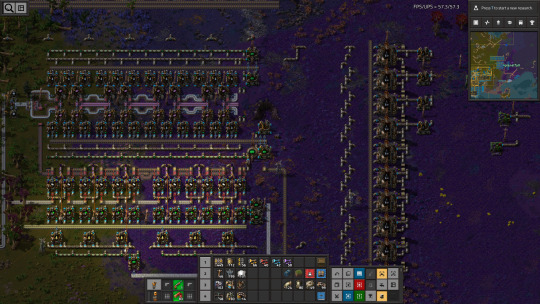
fuckin' bz chlorine and its marginally less oversimplified circuit boards
this is just for the substrates. i don't even have silicon wafers yet. at least those are easy
#factorio#not sure whether i will redo this for beacons/modules tbh. annoyingly only some of these processes can be prodmodded.#this is overkill on pvc but i have cooling fans to make later#(idk if cooling fans are actually made from pvc irl. it's just the default “plastic” item.)
11 notes
·
View notes
Text
Oh no Factorio is getting its hooks back in me. I am at the point where I am just a few steps away from having large-scale module production and then everything will be so much easier

5 notes
·
View notes
Text


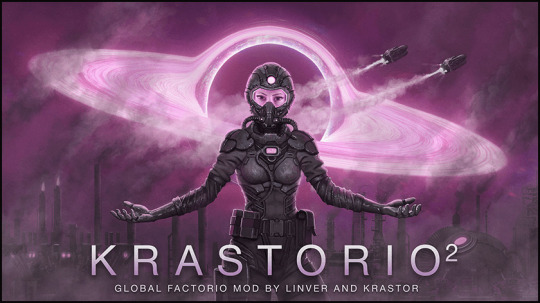
Today in Factorio: Modules 1 & 2
Watch the stream on Twitch
2 notes
·
View notes